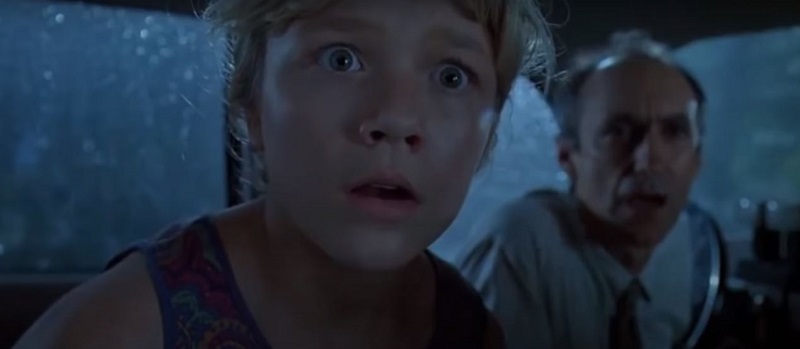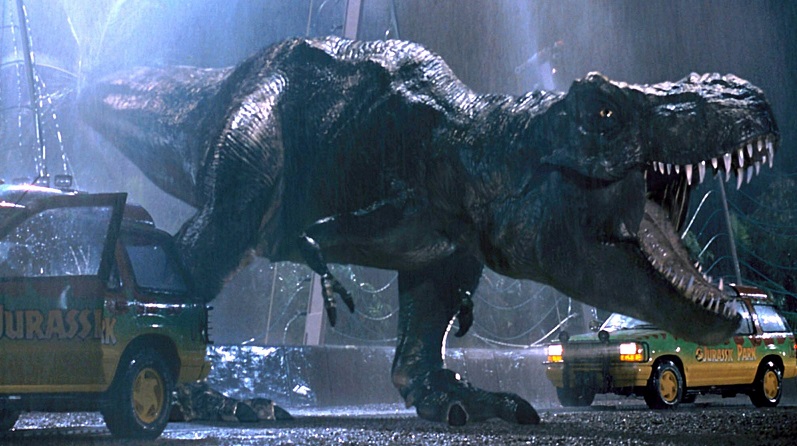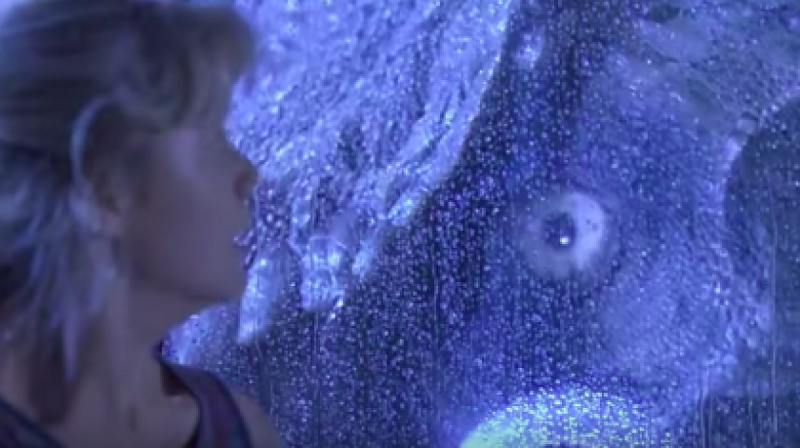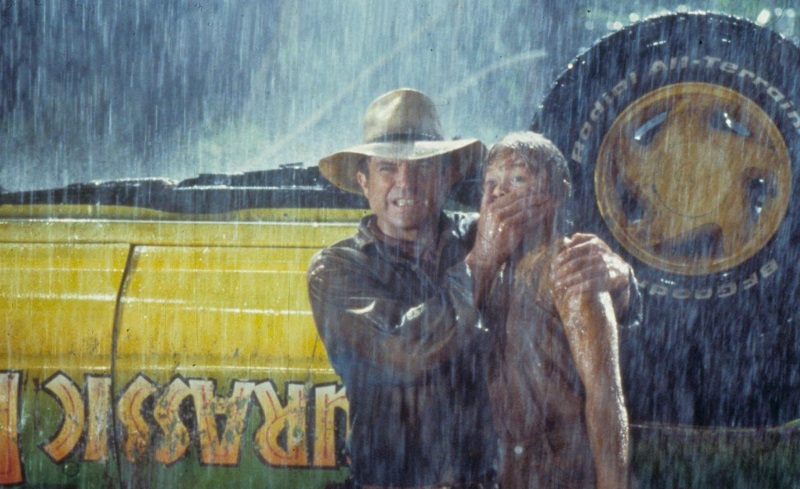With our second installment of The Movie Mensch’s monthly column that looks at cinematic perfection personified, The Perfect Scene points its spotlight at Steven Spielberg and his Jurassic Park. What strikes first about the two scenes we’re saluting, is that last month’s selection—Paul Thomas Anderson’s Boogie Nights—utilized Rick Springfield’s smash hit Jessie’s Girl as a sonic backdrop to its searing tension. Park’s filmmaker notably didn’t utilize any music with his The Perfect Scene. This is extraordinary, given that the moviemaking titan had the great John Williams at his disposal!
OK, so which scene from the 1993 instant classic is perfection? The Raptors and their door opening evolution? Nope. Watch those plastic cups of water shaking because here comes the T. Rex.
The Tyrannosaurus Rex escape and subsequent attack is not only textbook filmmaking at its finest, it is a master class in creating tension laced with humor. There is a myriad of iconic visual moments… just from this single scene. For starters, the wickedly effective close-up of the shaking plastic water glasses, whose rippling gets more intense as the seconds tick away.
What Spielberg achieved with that scene was multifaceted. As a goat was trotted out, this serves as the first time Grant (Sam Neill) and Malcolm (Jeff Goldblum), along with Hammond’s grandkids, would see the T. Rex. It was also the first time that audiences witnessed a real threat to our protagonists, this is long before crossing a Velociraptor or two.

In a time of extreme stress and crisis, the real core of who someone is comes floating to the surface. David Koepp and Michael Crichton’s screenplay (based on Crichton’s bestselling book) utilized this aspect of the human condition to illustrate the selfishness of the corporate world (here, embodied by Martin Ferrero’s Gennaro) as well as the innate heroism of Malcolm and Grant.
Prior to this instant, Goldblum’s character was outwardly selfish and a tad narcissistic. Nothing self-centered about leaving the relatively safe confines of the SUV to lure a T. Rex away from two terrified children to dispel that sentiment. There’s also the surprising emergence of a paternal streak from the previously “anti-parent” Grant. When Hammond’s grandkids, Lex (Ariana Richards) and Tim (Joseph Mazzello), become the focus of the T. Rex, screenwriters chose the most intense of times for something inherently innate to come to the forefront in Neill’s character. Those kids become his mission. As the scene progresses (and most importantly, after the scene concludes and the three are on their own in the jungle), the good doctor rises to the task.
Those are the players in this scene, now, onto the movie magic of Spielberg and what exactly he did that has us calling the T. Rex attack sequence one of the rarest of Hollywood entities, The Perfect Scene.
Hitchcock famously spoke about staging a scene where there is a bomb under the table and two people are simply chatting about baseball, blissfully unaware of their impending doom. So often filmmakers (rightfully) put a premium on what is not shown as a way of raising those hairs on the back of your head. What Spielberg does in this initial T. Rex attack is right in the Hitchcock wheelhouse. Show the audience the bomb. In this instance, it is the king of the prehistoric jungle. Then, take us inside those two SUVs sitting idly. Establish the fear by the subtlest of means. It’s been over a quarter-century since the film rocked our world. Folks still are haunted by the mere mention of rippling water glasses on the dash. The chain that was once attached to a goat is now swinging back and forth, empty. This cues audiences that this just occurred. The master achieves so much with so little. It’s simple, really. A glass of water, shaking exponentially fiercer as the seconds tick by… then, we see what’s left of the goat carcass as it lands on the kids’ moonroof with a disturbing thud. Now… it’s time to be afraid. Very afraid.

Spielberg’s use of rain is a fascinating choice, especially given the vacuum left by a silent score. It adds something intangible, especially after the embodiment of corporate greed races out of the car to go hide in the bathroom. As the camera pulls back from inside the SUV, Lex repeats, “He left us” over and over. Immediately after, the only sound we hear at this point is… rainwater. Things are about to get tenaciously tense. Smartly, the script delivers some levity with Gennaro running, out of blind fear, towards the bathroom. To which Malcolm utters, “When you gotta go, you gotta go.”
Not a millisecond passes before an earthy thud sends Malcolm and Grant’s heads swiftly turning away from Gennaro. Whatever noshed on that goat is still hungry. As Spielberg shoots it, that simple movement of two characters’ heads triggers something inside each audience member. This is about to get insanely dangerous. The sound of formerly electrified wires tearing apart as the T. Rex steps out from its foliage containment to the concrete road is soon blown away by that iconic roar that lets us all know who the king of the jungle is. Spielberg inserts another slice of humor (a chance to laugh and inhale deeply before things get fiercely frantic) as Malcom utters, “I hate being right.” Which is funny, because what little we’ve been introduced to Goldblum’s most popular character, it is easy to discern that he rather enjoys being correct all the time.
Screenplay and visual representation come together flawlessly as Crichton has Grant extol some knowledge about the enormous beast and how it responds to movement in the dark. This utterance comes just as Lex scurries around the back of her SUV and finds a flashlight. The filmmaker returns to the POV of Grant as he utters, “Turn the light off.” Its beam alerts the T. Rex exactly where two nice little morsels can be found.

Spielberg has a long history of iconic big-screen moments that will be dissected for decades and even centuries to come. Many of those are “perfect scenes.” There is just something about this particular swath of time in Jurassic Park that is utterly indelible. It occurs during a point in the film where the wonder and awe of witnessing dinosaurs are fresh and palpable. The director takes that jaw-dropping marvel and rips the carpet from underneath it and replaces it with righteous panic and suspense.
He also possesses an innate gift of casting young actors and actresses who turn in performances that eclipse their age and experience level. From E.T. to Empire of the Sun these youthful thespians are thrown into the fire of varying heat and by doing so, their mere presence exponentially elevates the peril. In his first foray into Crichton’s divinely dino world, Mazzello and Richards had been footloose and fancy-free up until now. Having the grand-kids of the park’s founder take this first tour seems like a great idea—after all, they are largely the demographic would be begging parents to go to such a place. What else it achieves is add an emotive tether between the viewer and what’s occurring onscreen that strikes deeply in everyone’s soul. These are children, after all, who suddenly find themselves in the crosshairs of a T. Rex. As such, our fear factor shoots through the roof.
Making matters worse, since Gennaro ran away from the SUV, these kiddos are alone in a situation that could not be more terrifying. The adults, Grant and Malcolm, are more psychologically and physiologically equipped to process and respond to a terror-laced situation. Spielberg exploits that innate human care for the young to add layers to the hair-raising tension that encapsulates this scene. Like the filmmaker did in War of the Worlds, or any number of his pictures, the violation of youthful innocence does wonders for elevating the stakes of any suspenseful scene. The perfect storm of history’s most prolific predator with children in danger is what motivates Grant and Malcolm to each do what they do to ensure Tim and Lex’s safety.
Every frame is tension. The T. Rex is out. Tim silently and swiftly moves to close the door left open by Gennaro. When the young man closes the car door as quietly as possible, the beast rapidly turns itself towards the kids’ SUV. The dinosaur lets out another roar as we get close-ups of the kids, individually. Terror rapidly increases.

Spielberg’s attention to detail—a common thread throughout his career—comes through repeatedly during the sequence. Just one example, when Lex is struggling with turning off the high-powered flashlight and the T. Rex approaches her window, as the flashlight hits the enormous beast’s eye, it contracts. Now, he didn’t have to do that or devote some special effects wizard’s precious (and expensive) time to making it happen. Had he not added that detail, the master storyteller would have lost sleep over it! His perfectionist nature is just one spoke in the wheel that is his awesomeness. That one detail spotlights the filmmaker’s virtuosity as it adds layers of authenticity to not only this particular moment in the movie… but the overall feel of the entire endeavor.
As the T. Rex bumps the kids’ SUV, the camera takes the perspective of the enormous prehistoric creature as its head briskly pushes on the sunroof as it snaps away from its seal like it was nothing. We visually rush towards the car—as if we are the dinosaur. As such, the striking primal fear of two children in jeopardy comes rushing right into our veins. Now, the T. Rex is in the car as youthful screams permeate the park air. It bashes the car with its head until it flips. The dino starts to crush the vehicle with its feet, as more childish screams wash over us like a terror-inducing tsunami.
At this point, one may think you’ve had enough of the hair-raising action, but no… Spielberg seeks to further up the ante. As the T. Rex’s weight slowly pushes the SUV into the mud, the very real possibility of the kids drowning in muck becomes close, prompting Grant to act. A flare will do nicely. Unfortunately, Malcolm also lights a flare. Our horror focus shifts, the dinosaur was going to follow Grant’s tossed flare. Unfortunately, the rock star scientist didn’t think this through as Malcolm holds his flare in the air, becoming target number one for our hungry beast.
Tim’s foot is stuck under something in the car (another suspenseful turn of events), so Grant turns to Lex and pulls her from the car, and informs her, “he can’t see us if you don’t move.” Then, Spielberg has his giant antagonist get within a nose hair of the two, literally breathing on them. Can you beat that in terms of building tension? No, no you cannot. The T. Rex even blows Grant’s hat right off his head. A “game” of hide and seek commences with Grant and Lex moving with the vehicle as the T. Rex tosses it in circles like a rag doll, all while Tim tries to avoid drowning by mud. Oh, did I mention that Grant and Lex almost fall off the road to the deep cavern below? Sure, why not? Throw in some more tension, why don’t you, Mr. Spielberg?
Just wait, there’s more.

Grant decides to propel down the wall with Lex hanging around his neck, all as the dinosaur slowly edges the SUV (with Tim in it) closer to the edge. What’s a man to do? That car is coming at them and they must hurry, ramping up the suspense even further. If thrills were “in the red,” this Jurassic Park scene would be searing scarlet. Grant and Lex get out of the way of the falling car, literally in the nick of time.
Cue: One last roar.
This is merely the second of what promises to be an entire series of “perfect scenes.” The Jurassic Park T. Rex attack on our protagonists, odds are, will be the first of several that come from Spielberg. Sometimes a filmmaker and technology meet at a moment in time that produces genius incarnate. In the early 90s, CGI had advanced in such a manner that audiences could finally see a dinosaur onscreen that looked like what one would expect a wiped out species could look like—without the jerky stop-motion miniatures that previously were the norm. After all, it was Spielberg who notoriously had an impossible time with that animatronic shark on the Jaws set in the 70s. It got so challenging that the entire film almost was scrapped… repeatedly.
Witnessing Jurassic Park, one can sense the pure unadulterated joy of an artist playing in a sandbox that finally meets his imagination. In the process, he upped the ante for moviemakers everywhere. Spielberg’s visual take on Crichton’s literary classic not only produced a “perfect scene,” but it simultaneously inspired countless dreamers whose work will be entertaining and enlightening us for generations.

